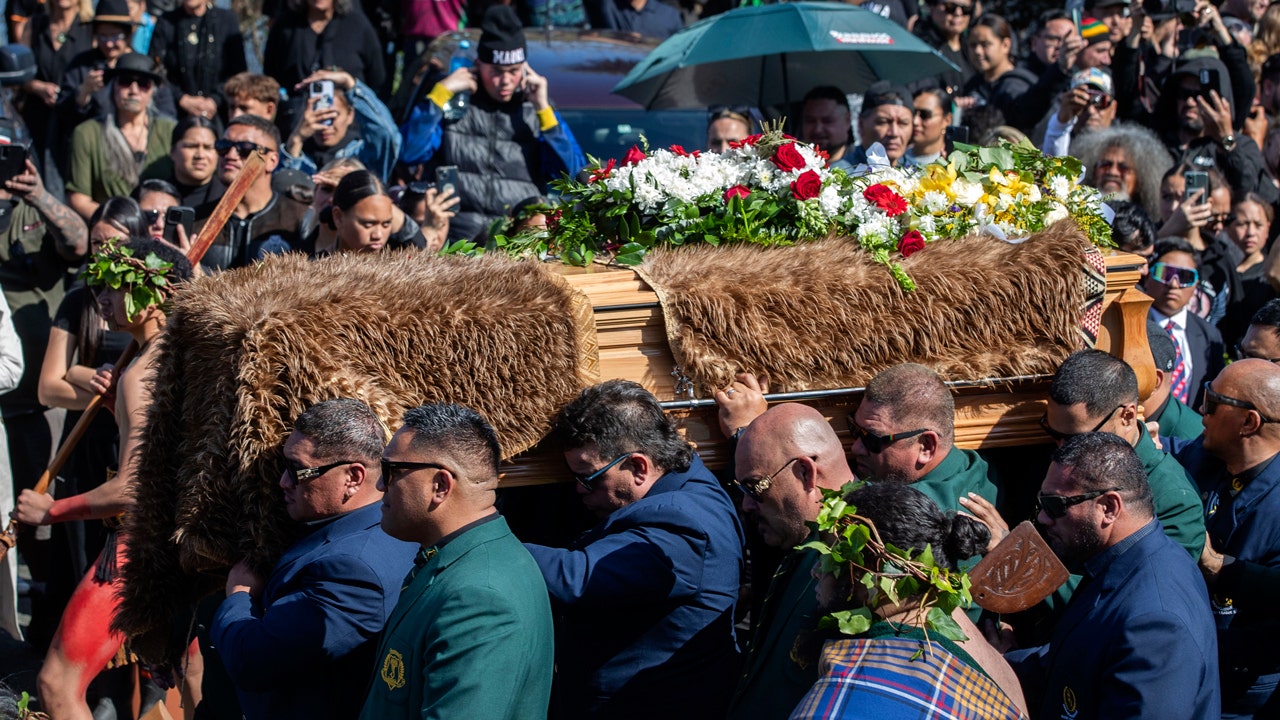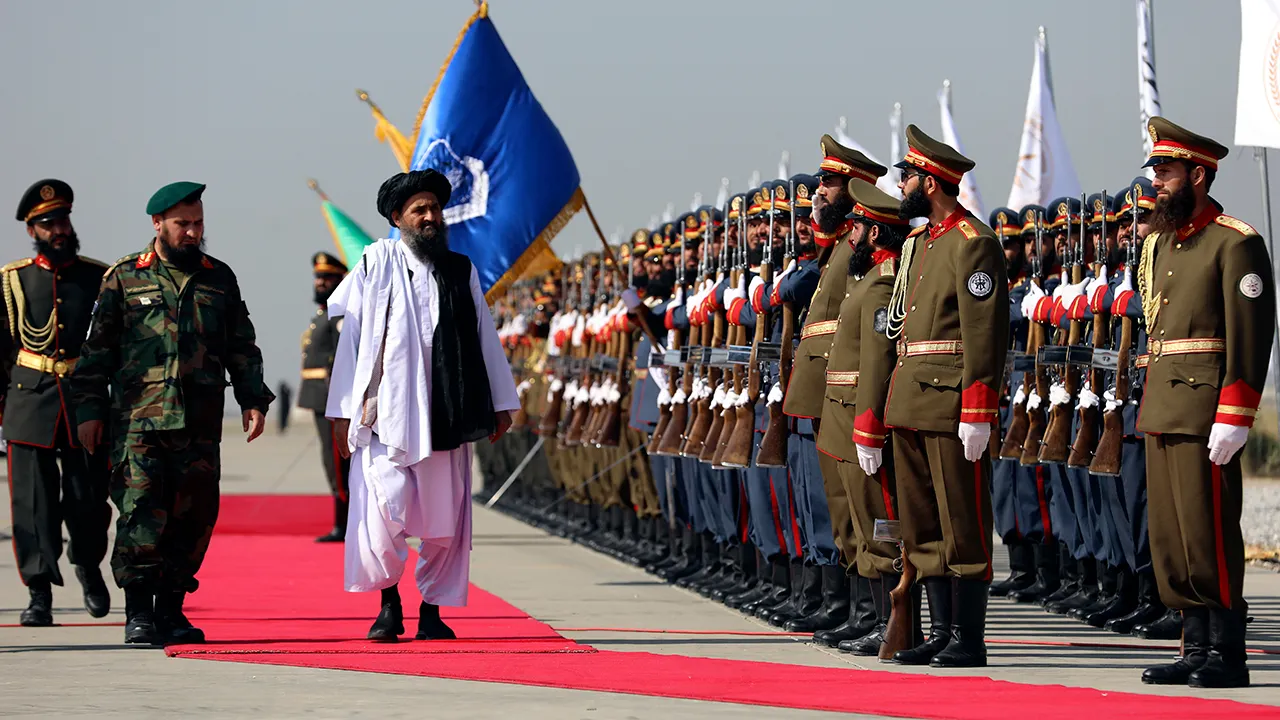World
New Zealand queen ascends to Māori throne at age 27

- New Zealand’s Māori king, Tūheitia Pōtatau Te Wherowhero VII, 69, has died. His daughter, Ngā wai hono i te po, 27, is the new queen.
- Ngā wai hono i te po is the second woman to become Māori monarch in a tradition dating back to 1858.
- King Tūheitia’s funeral was attended not only by Māori tribes, but by leaders of all political parties, past prime ministers, leaders of Pacific Island nations, diplomats and representatives of the British crown.
They came in their thousands in the freezing dawn, parking cars far away and winding down rural roads on foot, children riding on their shoulders. They arrived in mourning black with crowns of ferns and kawakawa leaves, bone carvings or wedges of deep green pounamu — New Zealand jade — resting on their chests.
The mourners came to the North Island town of Ngāruawāhia on Thursday to pay final respects to New Zealand’s Māori king, Tūheitia Pōtatau Te Wherowhero VII, who died six days earlier, and witness the ascension to the throne of his daughter, Ngā wai hono i te po. The new queen, 27, is the second woman to become Māori monarch in a tradition dating back to 1858.
As she was escorted onto Tūrangawaewae marae — an ancestral meeting place — where her father’s casket lay draped in feathered cloaks, cheers rang out among thousands crowded around TV screens outside and waiting along the wide, flat banks of the Waikato River to glimpse Kīngi Tūheitia’s funeral procession. After her ascension, Ngā wai hono i te po accompanied the late king in a flotilla of traditional canoes along the river as he was guided by Māori warriors to his final resting place.
NEW ZEALAND INQUIRY REVEALS ‘UNIMAGINABLE’ ABUSE IN CARE INSTITUTIONS OVER 5 DECADES
The events marked the end of a weeklong tangihanga — funeral rite — for Kīngi Tūheitia, 69, a leader who had in recent months rallied New Zealand’s Indigenous people to unity in the face of a more racially divisive political culture than before. His daughter’s ascension represents the rise of a new generation of Māori leaders in New Zealand — one which grew up steeped in a resurging language that had once almost died out.
Kīngi Tūheitia died last Friday after undergoing heart surgery, just days after celebrations marking his 18th anniversary on the throne. He became king after his mother’s death in 2006 and on Thursday was buried alongside her in an unmarked grave on Taupiri Maunga, a mountain of spiritual significance to his iwi, or tribe.
The Kīngitanga, or Māori royalty movement, is not a constitutional monarchy and King Charles III of Britain is New Zealand’s head of state. It has a ceremonial mandate rather than a legal one and was formed in the years after British colonization of New Zealand to unite Māori tribes in resistance to forced sales of Indigenous land and the loss of the Māori language and culture.
The coffin with the body of New Zealand’s Maori King, Kiingi Tuheitia Pootatau Te Wherowhero VII, is carried up Taupiri Mountain for burial in Ngaruawahia, New Zealand, on Sept. 5, 2024. (AP Photo/Alan Gibson)
Monarchs have traditionally wielded politics lightly and Tūheitia was remembered this week as a quiet and humble man. But in recent months, his voice had become louder.
After a center-right government took power in New Zealand last November and began to enact policies reversing recognition of Māori language, people and customs, Tūheitia took the unusual step in January of calling a national meeting of tribes which was attended by 10,000 people.
“The best protest we can make right now is being Māori. Be who we are. Live our values. Speak our reo,” he told them, using the Māori word for language. “Just be Māori. Be Māori all day, every day. We are here. We are strong.”
Tūheitia urged New Zealanders to embrace the concept of kotahitanga — unity of purpose — in a cause that he said had “room for everyone.”
His words were echoed throughout the days of his funeral, including by political leaders whose plans he had rallied to oppose. In a reflection of the place that Māori language and customs have grown to hold in New Zealand’s public life in recent decades, his funeral was attended not only by Māori tribes but by leaders of all political parties, past prime ministers, leaders of Pacific Island nations, diplomats and representatives of the British crown.
Tens of thousands of ordinary people also flocked there. Many spoke to each other in Māori, a language which had steadily waned after colonization until activists in the 1970s provoked its renaissance. Among their initiatives was the establishment of Māori language pre-schools, the first graduates of which are now young adults.
Tūheitia’s daughter was among them; while her father hailed from a generation in which many were discouraged from speaking Māori, she was steeped in it, attending Māori immersion schools. Ngā wai hono i te po holds a degree in Māori customs and is an accomplished performer of kapa haka, an Indigenous performance art.
The late king, a truck driver before he took the throne, was a surprise appointment to the monarchy, which is chosen by a council and is not required to be hereditary. But the new queen was groomed for the role and had accompanied her father in his work during recent years.
Her ascension comes at a fraught political moment. Since 1858, the Kīngitanga has championed Māori sovereignty and the other promises of modern New Zealand’s founding document, the Treaty of Waitangi, signed in 1840 between the Crown and Māori tribes. In the years since, translation issues and attempts to reinterpret the treaty have at times provoked conflict, which has in recent months flared again.
“The treaty provides a foundation for us all to work together. Let’s not change it, that would harm us,” Tūheitia said at the event marking his coronation days before his death. While New Zealand was facing a storm as Māori rights were rolled back, “there’s no need to worry. In this storm, we are stronger together,” he said.
After the new queen was anointed with oils and a service for her father held, mourners flocked behind the hearse as it drove to the banks of the river sacred to his tribe. There, Tūheitia’s casket was accompanied by traditional carved canoes on his journey to the mountain, with mourners, in some places 10 people deep, falling silent and bowing as he passed.
As he was carried to the foot of the mountain under a clear afternoon sky, a roaring haka, or ceremonial chant, rang out from mourners waiting among gravestones dotted up the steep hillside and dozens helped to carry the late king to his burial place at the top.
Many had waited for hours to see the procession pass, including a large number of young families. Commentators said the queen’s ascension represented the culture’s renewal, with the majority of Māori — who account for almost 20% of New Zealand’s population — aged under 40.
Among them on Thursday was Awa Tukiri, 9, whose family had driven nearly two hours from Auckland to watch the canoe carrying the late king pass by.
“It was pretty amazing because all they do on the boat is do haka and waiata on it,” he said, using the words for Māori chants and songs. Tukiri, who attends a kura kaupapa — the immersion schools that are growing in popularity — said the best part of being Māori was “just hanging out and speaking Māori to each other.”

World
Looking for a job in IT? These countries are desperate for new hires

Over two-thirds of large companies struggle to fill their IT roles. What are the highest-paid jobs? Which countries are most in need?
As the IT sector continues to grow, thousands of European companies are having trouble filling the many positions available.
According to 2024 Eurostat data, 57.5% of EU businesses can’t recruit all the necessary ICT specialists.
The gap between labour demand and actual employment has grown by 20% in the past ten years.
Large businesses are facing the biggest challenges.
Sixty-eight per cent of them are unable to fill all their ICT specialist positions, followed by medium (59.2%) and small-sized enterprises (53.4%).
Germany, the Czech Republic, Malta, Austria, and Luxembourg are the countries most in need of ICT specialists, with at least 65% of businesses facing shortages.
The percentages are even higher for large enterprises: 84% in Malta, 80% in Germany, 79% in the Czech Republic, 78% in Slovenia, 76% in Austria, 75% in Luxembourg, 73% in Latvia, 72% in Hungary and 71% in Croatia.
Spain, Poland, and Bulgaria have the least hiring problems, although at least 30% of companies in these countries still face ICT shortages.
What are the highest-paid IT positions?
The main difficulties in recruitment, according to Eurostat, are a lack of applications, insufficient qualifications and experience, and high salary expectations.
Salaries in the ICT sector have consistently outpaced average wages in Europe in the last decade, according to the 2024 OECD Digital Economy Outlook. In the EU, in particular, annual wages grew by 0.24% compared to 0.20% in the rest of the economy.
Recruitment specialists Robert Walters have listed the top-paid ICT jobs in countries including Germany, which seems to be struggling the most in the EU to recruit specialists.
The highest-paid role is Chief Information Technology Officer, with an annual base of €150k for employees with at least three years of experience, to €180k for those with at least eight years.
The consultancy role in the highest bracket is the SAP/ERP one, with a base of €100k. (SAP ERP is an enterprise resource planning software.)
Data engineer and data scientist positions are both in the €100-120k bracket.
Video editor • Mert Can Yilmaz
World
TVLine Items: Ringo Starr Concert Special, Ms. Rachel to Netflix and More

ad
World
India steps up diplomatic relations with the Taliban as rival Pakistan loses influence in Afghanistan

India’s foreign secretary, Vikram Misri, met acting Afghanistan Foreign Minister Amir Khan Muttaqi in Dubai last week, making a strong leap forward in bilateral relations.
While India has been gradually increasing its engagement with the Taliban, this latest meeting represents the highest-level talks since the Islamic group’s takeover of Afghanistan in 2021. Notably, this was the second meeting between officials from New Delhi and Kabul in just two months, indicating both countries’ readiness to step up diplomatic engagement.
“We shouldn’t overstate the impact of Pakistan’s tensions with the Taliban on India’s stepped up engagement with the Taliban. New Delhi had already taken some small steps toward Taliban engagement soon after the Taliban’s return to power, before tensions crept into the Taliban’s relations with Pakistan,” Michael Kugelman, director of the South Asia Institute at the Wilson Center, tells Fox News Digital.
TALIBAN GOVERNMENT TO CEASE OPERATIONS AT AFGHAN EMBASSY IN INDIA’S CAPITAL
Narendra Modi, India’s prime minister, addresses the media at the Parliament House in New Delhi on Dec. 7, 2022. (Prakash Singh/Bloomberg via Getty Images)
During the discussions, Misri emphasized the “historic friendship” and “strong people-to-people contacts” between the two nations. Meanwhile, the Afghan foreign minister described India as “an important and economically significant country in the region.”
According to a statement from India’s Ministry of External Affairs, the talks focused on strengthening bilateral relations, addressing security concerns, engaging in development projects and enhancing humanitarian assistance.
India is among several countries actively facilitating trade, aid and medical support to Afghanistan under the Taliban regime. The country, which hosts thousands of Afghan refugees, also pledged to provide “material support” for their rehabilitation back in Afghanistan.
“New Delhi’s outreach to the Taliban is driven by the view that closer engagement can help India better pursue its security and strategic interests in Afghanistan – and these include strengthening trade and connectivity links and ensuring India isn’t threatened by terrorists on Afghan soil,” Kugelman explained.
BIDEN ADMIN’S AFGHANISTAN WITHDRAWAL FAILURES DETAILED IN REPORT
The discussions also touched on enhancing trade via the Chabahar Port in Iran’s Sistan-Baluchestan province. India has been developing the Chabahar Port to enable goods to bypass ports in its rival, Pakistan. This strategic port, which lies just across the border from Pakistan, could provide landlocked Afghanistan with an alternative route to receive and send goods, circumventing Pakistan.

Afghan refugees living in Pakistan rally against India in Lahore, Pakistan, Feb. 28, 2019. (AP Photo/K.M. Chaudary)
The meeting between India and the Taliban could unsettle Pakistan, which shares borders with both countries. India and Pakistan are long-standing rivals, having fought three wars over Kashmir since both countries gained independence in 1947. This meeting also takes place amid deteriorating relations between the Taliban regime and Pakistan, once considered friendly neighbors, as cross-border violence escalates.
PAKISTANI AIRSTRIKES TARGET TALIBAN IN AFGHANISTAN FOLLOWING SUICIDE BOMBING
The talks occurred just days after India “unequivocally” condemned Pakistani airstrikes in Afghanistan in late December. These rare airstrikes resulted in the deaths of dozens of civilians, including women and children. Pakistani officials claimed the strikes targeted militants of the Pakistani Taliban. Islamabad frequently accuses the Pakistani Taliban of using Afghan territory to launch attacks in Pakistan, a charge Kabul denies.

People gather at the border crossing between Pakistan and Afghanistan, in Chaman, Pakistan, Aug. 11, 2021. (AP Photo/Jafar Khan)
The diplomatic engagement also follows the Taliban’s appointment of an acting consul in the Afghan consulate in Bombay in November, the same month India’s joint secretary of the Ministry of External Affairs visited Kabul. Although no foreign government, including India, has officially recognized the Taliban administration since it swept to power in 2021, India reopened its embassy in Kabul less than a year after the Taliban’s return to power.
“Islamabad has already seen its relations with its former Taliban asset take a major tumble,” Kugelman, said. “Now it must grapple with the fact that its rival India may fill the vacuum left by Pakistan’s distancing from the Taliban. No matter how you slice it, this is bad news for Pakistan all around.”
BIDEN SAYS HE’S LEAVING TRUMP ‘STRONG HAND TO PLAY,’ DEFENDS HIS RECORD ON AFGHANISTAN
Several factors, in addition to deteriorating Pakistani relations, may have led India to strengthen its relationship with Afghanistan. The weakening of Iran, due to conflicts in the Middle East and internal issues, has diminished its influence over the Taliban. At the same time, Russia, one of India’s closest allies, is moving toward recognizing the Taliban government in Afghanistan, even calling the group a partner in combating terrorism. Moscow perceives a significant security threat from Islamist militant groups across countries from Afghanistan to the Middle East, especially after losing Bashar al-Assad in Syria.

Hundreds of people gather near a U.S. Air Force C-17 transport plane at a perimeter at the international airport in Kabul, Afghanistan, on Aug. 17, 2021. (AP)
China is also enhancing its connections with the Taliban, causing India to be wary of Beijing’s increasing influence. Additionally, India’s approach may be influenced by President-elect Trump’s imminent return to the White House. The Trump administration initially brokered the U.S.-Afghanistan withdrawal deal. Trump’s re-election could now introduce new dynamics to the region, prompting India to safeguard its long-term interests.
In contrast, the United States has severed diplomatic ties with Kabul since its chaotic withdrawal from war-torn Afghanistan. Washington maintains a policy of sanctions and isolation toward Taliban leaders. But now, nations in the region are evaluating the implications of a new Trump administration for the Taliban.
-

 Health1 week ago
Health1 week agoOzempic ‘microdosing’ is the new weight-loss trend: Should you try it?
-
/cdn.vox-cdn.com/uploads/chorus_asset/file/25822586/STK169_ZUCKERBERG_MAGA_STKS491_CVIRGINIA_A.jpg)
/cdn.vox-cdn.com/uploads/chorus_asset/file/25822586/STK169_ZUCKERBERG_MAGA_STKS491_CVIRGINIA_A.jpg) Technology6 days ago
Technology6 days agoMeta is highlighting a splintering global approach to online speech
-

 Science3 days ago
Science3 days agoMetro will offer free rides in L.A. through Sunday due to fires
-
/cdn.vox-cdn.com/uploads/chorus_asset/file/25821992/videoframe_720397.png)
/cdn.vox-cdn.com/uploads/chorus_asset/file/25821992/videoframe_720397.png) Technology7 days ago
Technology7 days agoLas Vegas police release ChatGPT logs from the suspect in the Cybertruck explosion
-

 Movie Reviews1 week ago
Movie Reviews1 week ago‘How to Make Millions Before Grandma Dies’ Review: Thai Oscar Entry Is a Disarmingly Sentimental Tear-Jerker
-

 Health1 week ago
Health1 week agoMichael J. Fox honored with Presidential Medal of Freedom for Parkinson’s research efforts
-

 Movie Reviews1 week ago
Movie Reviews1 week agoMovie Review: Millennials try to buy-in or opt-out of the “American Meltdown”
-

 News7 days ago
News7 days agoPhotos: Pacific Palisades Wildfire Engulfs Homes in an L.A. Neighborhood













